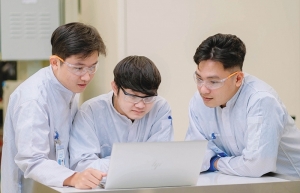Vietnam to ramp up its semiconductor workforce
The Ministry of Information and Communications must finalise the Vietnam Semiconductor Industry Development Strategy, whilst the Ministry of Planning and Investment (MPI) must complete the Human Resources Development Plan for the Semiconductor Industry to 2030, with a vision to 2045.
The objective of these initiatives is to have 50,000 engineers trained by the end of the decade. Currently, Vietnam has nearly 5,600 semiconductor design engineers, according to the National Science and Technology Portal. To meet market demand, the country must have 10,000 semiconductor engineers each year. At present, domestic human resources only meet half of this target.
Discussing semiconductor workforce development in Vietnam with local media, Do Thi Thuy Huong, a board member of the Vietnam Electronic Industries Association, said, "Along with design engineers, the industry urgently needs experts who, despite having only college-level education, possess strong expertise in production organisation, an area where Vietnam still lacks. Training should also be closely linked with educational institutions and businesses. If training remains too academic, it will be difficult to ensure practical skills, especially given the rapid pace of technological change."
Vietnamese universities and educational centres are rapidly stepping up their involvement in semiconductor workforce training. According to the Ministry of Education and Training, Vietnam has about 35 higher education institutions directly training or closely related to the semiconductor industry. Top institutions for training graduates and engineers in the semiconductor field include Hanoi University of Science and Technology, Vietnam National University in Hanoi, and Vietnam National University in Ho Chi Minh City.
For the 2024-2025 academic year, Phenikaa University has announced two new semiconductor-related programmes, namely 'Semiconductor Circuit Design' and 'Semiconductor Chips and Packaging Technology'.
Last year, Hanoi University of Science and Technology introduced a Microchip Design specialisation within its Electronics & Telecommunications Engineering and Microelectronics & Nanotechnology Engineering programmes.
Moreover, Vietnam has strengthened partnerships with multinational technology corporations to align workforce training with global industry standards.
Synopsys signed a partnership with Vietnam National University in Ho Chi Minh City to develop talent in integrated circuit design in March, while in June, Phenikaa University, in collaboration with Synopsys, launched a 'Train the Trainers' course on semiconductor circuit design for university lecturers, engineers, and students.
Intel has also pledged support to the Danang Semiconductor and AI Research and Training Centre, committing to organise training courses for instructors in AI.
In early July, during a meeting with PM Chinh in Seoul, South Korean president pledged to support Vietnam in training semiconductor and high-tech industry personnel.
According to the MPI’s plan, the goal of training 50,000 semiconductor industry personnel includes 15,000 semiconductor circuit design engineers, 35,000 engineers in other semiconductor fields, and at least 5,000 AI specialists.
The estimated budget to achieve these goals by 2030 is about VND26 trillion ($1.08 billion), with VND17 trillion ($708 million) from the state budget and VND9 trillion ($375 million) from social sources.
Vietnam’s favourable geography, affordable labour, and open policies have made it a magnet for major semiconductor companies from the United States, Germany, China, and South Korea.
Speaking at a conference on human resources in the semiconductor industry in April, Minister of Planning and Investment Nguyen Chi Dung said, "Comprehensive cooperation with the major semiconductor nations, economies, and companies is necessary to leverage Vietnam's human resource advantages and become a significant player in the semiconductor industry."
 | Tie-ups grow for microchip advancement Training up a workforce for the semiconductor industry is heating up thanks to the involvement of universities in Vietnam. |
 | FIE and university tie-ups to breed high-tech workforce Collaboration between Vietnamese educational institutions and foreign-invested enterprises is paving the way for creating a more competent and globally ready high-tech workforce. |
 | Vietnam commits $1.08 billion to train 50,000 semiconductor engineers by 2030 Vietnam has underscored its ambition to develop a skilled workforce for the semiconductor industry, aligning with its vision to deeply integrate into the global value chain, spurred by robust industry growth and strategic international partnerships. |
| A strengthened high-tech workforce for semiconductors Vietnam has plenty of work to do if it wants to become a true global hub for semiconductor manufacturing. Dr. Quan Le, principal investigator for the Semiconductor Workforce Development Research Grant under Fulbright University Vietnam, covered the potential for Vietnam and how to reach it with VIR’s Vy Vy. |
| Call to arms for semiconductor roles Chip design is set to boom in Vietnam in the coming years, with many investors entering the market. However, human resource training needs more backing for the industry to achieve high quality and capture opportunities. |
What the stars mean:
★ Poor ★ ★ Promising ★★★ Good ★★★★ Very good ★★★★★ Exceptional
Related Contents
Latest News
More News
- Nghi Son refinery processes first non-Kuwaiti crude cargo (January 16, 2026 | 16:06)
- Siemens and VSIP announce landmark strategic partnership (January 15, 2026 | 14:48)
- VinFast sets record with 175,099 electric vehicles delivered in Vietnam in 2025 (January 15, 2026 | 14:24)
- Year-end shopping season faces rising uncertainty (January 14, 2026 | 18:11)
- State sector sees broad-based profit surge as major groups deliver strong results (January 13, 2026 | 17:34)
- HSBC forecasts Vietnam's GDP growth to hit 6.7 per cent in 2026 (January 13, 2026 | 17:33)
- Japfa maintains position in top 10 animal feed firms (January 13, 2026 | 10:18)
- Roadmap shaping up to phase out gas bikes (January 13, 2026 | 10:07)
- FDI momentum accelerates transformation of Vietnam’s plastics sector (January 11, 2026 | 07:00)
- UOB lifts Vietnam growth outlook to 7.5 per cent for 2026 (January 10, 2026 | 09:00)

 Tag:
Tag:
















 Mobile Version
Mobile Version